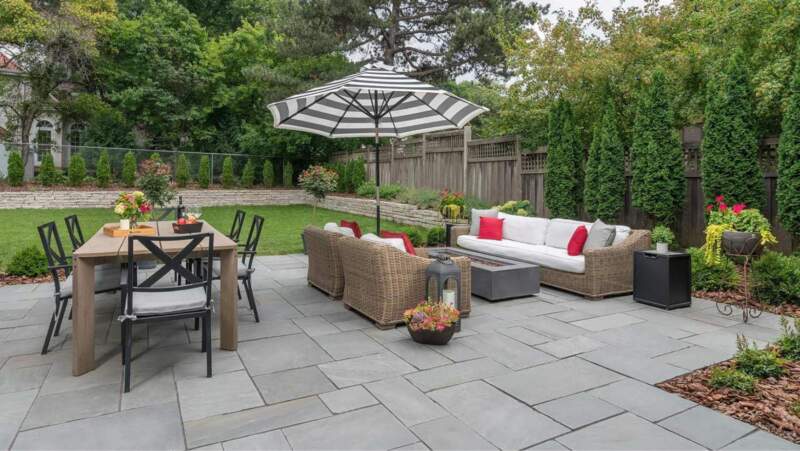Is your once-vibrant bluestone patio looking a little worse for wear, sporting unwelcome guests like rust stains and algae growth? Don’t despair! With a bit of know-how and some readily available tools, you can transform your patio back into a beautiful and inviting outdoor space.
What is Bluestone patio?
Bluestone is a natural stone prized for its durability, aesthetic appeal, and timeless elegance. Its subtle variations in color, ranging from soft grays to deep blues, add a touch of sophistication to any outdoor space. Bluestone patios can significantly elevate the value and curb appeal of your property, creating an inviting atmosphere perfect for entertaining or simply relaxing in the company of loved ones.
How much does it cost to install?
The cost of installing a bluestone patio can vary depending on several factors, including the size and complexity of the project, the type and thickness of the bluestone slabs, and your geographic location. Generally, expect to invest anywhere from $10 to $25 per square foot for materials and installation. While it may seem like a significant investment upfront, the durability and timeless beauty of bluestone make it a worthwhile choice for homeowners seeking to create a lasting outdoor retreat.
Maintain bluestone patio
The good news is that maintaining your bluestone patio doesn’t require extensive time or effort. Regular cleaning with a soft brush and mild soap or a pH-neutral stone cleaner will help prevent dirt, grime, and algae buildup. For tougher stains like rust, you might need to employ specific cleaning solutions, but with proper care, your bluestone patio can retain its charm for years to come.
With a little know-how and some elbow grease, you can banish these invaders and restore your patio’s pristine look. Let’s jump into a step-by-step guide to help you achieve patio rejuvenation:
tools you need
- Soft Bristle Brush: Think of this as your gentle giant. A nylon or plastic brush will effectively scrub away grime without scratching the delicate surface of your bluestone.
- Garden Hose: This trusty friend will be responsible for wetting down the battlefield and rinsing away the vanquished foes (rust and algae) after the battle.
- Bucket: Your trusty bucket will serve as your command center, holding your cleaning solutions and rinsed water.
- Dish Soap (or pH-Neutral Stone Cleaner): For mild cases of algae, a few drops of dish soap in water will do the trick. If you prefer a more specialized approach, opt for a pH-neutral stone cleaner designed specifically for natural stone surfaces.
- Baking Soda (Optional): This natural wonder acts as a gentle yet effective cleaning agent for stubborn algae.
- Trisodium Phosphate (TSP) Solution (Optional, Use with Caution): For particularly tenacious rust stains, TSP can be a powerful ally. However, due to its stronger nature, always handle it with caution and follow safety guidelines.
how to clean algae off bluestone patio
For Mild Algae
All you need is a slight approach for minor cases of algae. Pour some water into the bucket and mix in a few drops of dish soap. This easy recipe will be your go-to remedy for clearing algae. After dipping your soft bristle brush into the soapy water, gently clean the afflicted regions in a circular manner. Consider rubbing your patio; the secret is to use firm but mild pressure. Lastly, use your hose to thoroughly rinse the entire patio in order to get rid of the cleaning solution and any loose algae.
Stubborn Algae
Baking soda is effective for an algae infestation that is more difficult to get rid of. Combine a small amount of water and baking soda to make a paste. After liberally applying this paste to the afflicted areas, let it to sit for 10-15 minutes. The effect of the baking soda will be to weaken the algae’s hold on your patio. After the prescribed period has passed, use your reliable brush to scrub the affected areas in a circular motion using the baking soda paste. Lastly, use clean water to completely rinse the patio to get rid of the baking soda residue and any loose algae.
how to clean rust stains from bluestone patio?
For Mild Rust Stains
Often, a natural remedy may do for light rust stains. In your bucket, mix one part white vinegar to three parts water. After applying this solution to the soiled area, give it ten to fifteen minutes to sit. The rust particles will dissolve as the vinegar does its magic. Use your soft bristle brush to gently scrub the area after the waiting period. Lastly, completely rinse the patio with clean water to get rid of the cleaning solution and any loose rust particles.
For Harsh Rust Stains
A stronger solution could be required for rust stains that are really constant and won’t go away. But use caution! Although trisodium phosphate (TSP) is a more aggressive chemical, it can be an effective tool in the fight against rust. When handling TSP, always wear gloves and safety eyewear, and carefully follow the manufacturer’s recommendations. Generally, you would combine about a tablespoon of TSP with one gallon of water. Carefully apply the solution to the stained area, following the manufacturer’s recommendations, and allow it to sit for a few minutes. Once you’ve had time to wait, use the brush to scour the area and then immediately give the patio a thorough rinse with clean water.
By following these steps, you should be able to remove rust stains and algae from your bluestone patio and restore its natural beauty.
Despite the temptation, don’t wash your bluestone patio with a power washer!
Power washers are not advised for use on bluestone patios, even though they might appear like an effective approach to handle cleaning chores. The thin stone surface can easily sustain damage from a power washer’s high pressure, leading to:
The term “spalling” describes the uneven and unattractive surface caused by tiny bits of the stone chipping or flaking off.
Etching: The bluestone’s top layer may be worn away or etched by the strong jet, changing the stone’s original hue and texture.
Exposure of underlying material: In extreme circumstances, the tremendous pressure may even be able to erode the stone’s outer covering, revealing the underlying substance below.


